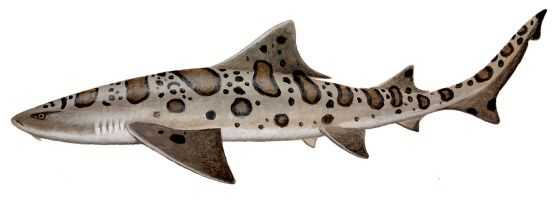Leopard Shark

Species Details
Triakis Semifasciata
Triakidae
Carcharhiniformes
Onshore, Nearshore, Reef
10 - 44 lbs.
50" - 78"
Leopard Shark (Triakis Semifasciata) Fish Description
The Leopard Shark may be from the “shark” family but they’re not as vicious as its cousins. Similar to the Whale Shark that also suffers from the same misconception, Leopard Sharks are not vicious. They’re virtually harmless. Their name, Leopard Shark, comes from the spots that cover its body. It has a long, slender body with the usual structures of a shark.
It has a tall dorsal fin with a moderately stout body to the point its still borderline slender. It also has a short, rounded snout with nares on the tip of their snout. The Leopard Shark also has wide, oval eyes with a well-developed eyelid that serves as a protective covering. They do have teeth despite their passive nature, around 41-55 for the top row and 34-45 on the lower row.
Leopard Shark Diet
Leopard Sharks love eating crabs. However, they do also eat bony fish such as anchovy, herring, croakers, topsmelt, gobies, rockfish, surfperch, midshipmen, flatfish, and croakers. Lepoard Sharks are also fine with eating shrimp, benthic and animals that stay near shore. They are also known to eat Ghost Shrimp if presented the opportunity and clams.
Leopard Shark Size
Leopard Shark are known to grow to at least 1.2 – 1.5 meters, a round 3.9 to 4.9 ft. However, males can grow past the average size but rarely do they reach past 1.5 meters. Whereas female Leopard Sharks can grow up to 1.8 meters. However, there’s been a record of a female Leopard Shark hitting at least 2.1 meters, weighing at 18.4 kg (41 lbs).
Interesting Facts about the Leopard Shark
- There was one Leopard Shark attack but there were no traces of bites or the sort on the victim.
- They generally are passive to humans. Leopard Sharks are more aggressive to fish.
- Leopard Sharks are active species. They like cruising around the bottom or slightly beyond the surf zone.
- They’re nocturnal creatures, meaning to easily catch a Leopard Shark might be best in the day rather in the night. Unless you want a good fight then, catching one at night is okay also. Catching Leopard Sharks in the morning might mean you’ll have to trace them all the way to their habitat where they lay low in the dark.
- Like their other cousins in the Shark family, Leopard Sharks give birth to live young.
- Female Leopard Sharks always follow the warmest patch of water.
- Leopard Sharks have more red blood cells, making them process oxygen a whole lot better than most fish.
- Leopard Sharks like their cousins are sensitive to blood. However, they are just known to harass rather than to attack. The single recorded attack from a Leopard Shark was due to the fact the diver had a nose bleed.
- Leopard Sharks are generally wary of humans.
- Leopard Shark can live up to 30 years but they grow very slowly.
Leopard Shark – Fishing Techniques: How to Fish for a Leopard Shark
To catch a Leopard Shark, you have to attract them with pieces they consider “candy”. These “candy” are baits made of squid and pacific mackerel chunks. However, herring, anchovies, small crabs, and sardines all work well also. Make sure the bait is positioned in the way that it won’t fall off the hook as the pressure might throw it off. Since Leopard Sharks lay more on the bottom, you’ll need a heavier weight to make sure the bait and hook don’t get thrown off.
If your bait is mushy, try tying a bait thread around it. That way, it won’t fly off. Also, keep the bait away from the sun so it doesn’t dry up.
As for your equipment, some recommend dropper loops and fish finder rigs with a 5/0 to 7/0 circle. Others would say octopus hooks would work just as well.
Leopard Shark fishing is under regulation. In some places, you’re only allowed to catch 3 Leopard Fish before the rest you have to perform CPR and release them back.
Leopard Shark Habitat
Leopard Sharks stay in bays and estuaries, normally at the shallower part. They do love roaming through kelp forests though where they usually patrol and hide underneath. At times, they can be found in deep waters but the deepest ever recorded was 300 feet.







